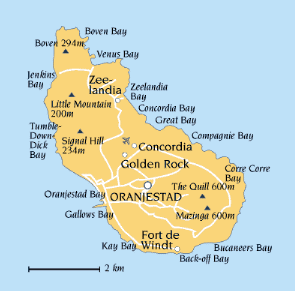Sint Eustatius
Introduction
Sint Eustatius, also known as Statia, or Saint Eustace, is one of the islands which make up the Netherlands Antilles; it is in the northern, Leeward Islands portion of the West Indies, southeast of the Virgin Islands. Sint Eustatius has a land area of 21km², and about 2000 inhabitants. The island lacks gorgeous beaches, but is dominated by the Quill volcano, which rises to 600 meters, is covered by rainforest and is a popular hiking destination. The island is also a popular diving destination.
Travel facts
Calendar
| Jan | Feb | Mar | Apr | May | June | July | Aug | Sep | Oct | Nov | Dec |
Diving Sites
-
description :Hangoverrating : 4.0depth : 18 m
The most important lava flow has created a narrow but very long plateau endowed with corals and inhabited by an intense and varied fauna. In some places a mini-wall with a height of 3 to 5 meters has been formed, with cavities providing shelter for lobsters. Schools of lutjans, soldierfish, surgeonfish, butterflies move through this coral garden, where immense gorgonians and equally imposing barrels emerge. All types of reef fish can be seen here. A large grey reef shark made a furtive intrusion before disappearing offshore. We also saw a large diodon, angelfish and gobies. In short, it's hard to see so much, especially as the average depth is around 15 meters, so the dive can easily last more than 60 minutes. -
description :Anchor Point Northrating : 3.0depth : 20 m
The dive takes place between 15 and 20 meters in an environment identical to that of other nearby sites, i.e. a succession of potatoes on a sandy bottom. At this location, a huge anchor from the 17th or 18th century can be found. The corals are beautiful, especially the barrels, whose size is impressive. We saw a huge turtle, large groupers and a nice-sized angelfish. -
description :Charles Brownrating : 3.0type of diving : wreckdepth : 31 m
This 100-metre-long vessel was used to lay underwater cables. It was volontarily sunk in 2003 as a dive site in Saint Eustatius. Its infrastructure is virtually intact, and it's easy to get inside. A huge barracuda is a permanent resident. Schools of trevally and lutjans are also present. We saw a stingray and a small turtle. The corals are interesting, but the main attraction of the dive is the wreck itself. -
description :Double Wreckrating : 3.0depth : 19 m
Two anchors lying on the sand some twenty meters away are all that remain of these two 18th-century wrecks. This is where half a dozen stingrays are concentrated, including two large ones. We also saw 3 turtles and a large porcupine, as well as gobies that move vertically before quickly returning to their holes as we approached. Schools of catfish dig their whiskers into the sand in search of a meal. A huge barracuda was waiting for us when we jumped in the water. And we saw them again on the way out. -
description :Nursing Stationrating : 3.0depth : 23 m
Continuation of Barracuda Reef. Plateau starting at 15 m. and descending to 20 m. On the wall, a healthy, multicolored coral with niches where up to a dozen lobsters could be seen. At the bottom of the small wall, a succession of small potatoes where nurse sharks were camouflaged, including one absolutely enormous specimen which decided to leave its den when we were close by. Lots of fish, magnificent and varied coral. -
description :The Blocksrating : 3.0depth : 18 m
The lava that poured into the sea formed small valleys that slope gently down to sandy bottom. We saw a reef shark and four stingrays nestling in the sand. We also saw half a dozen lobsters and a few moray eels, apart of course from the usual reef fauna. -
description :Barracuda Reefrating : 2.0depth : 21 m
A very long lava flow has formed a mini wall riddled with small caves now covered with healthy, multicolored corals that are home to a very diversified fauna. This site is supposed to be home to a large colony of barracudas... but they weren't there that day. This site is also called Barbecue Reef in reference to the impressive number of lobsters that take refuge here; enough to feed a regiment of gourmets. -
description :Down Southrating : 2.0depth : 37 m
The anchor line drops to a depth over twenty meters. We swim for over 3 minutes at a depth of 15 meters towards a wall that starts at 18 meters and drops vertically to 38 meters. Less fishy than the other sites, but gigantic gorgonians and no less imposing barrels. We also saw a large school of trevally and a napoleon wrasse. -
description :Triple Wreckrating : 2.0depth : 19 m
Several slightly raised coral surfaces surrounded by a sandy bottom. Abundant small to medium-sized corals, on which we saw several nudibranchs. A small nurse shark was trying (in vain) to hide in a small cave. Lots of juvenile fish, but little adult ones. We also saw a moray eel, several flatfish immobilized on the sand, harlequins and lobsters. The sandy floor is littered with conchs, which retract into their shells when turned over. -
description :Blue Bead Holerating : 1.0depth : 18 m
On a sandy bottom, a few scattered mini-corals are frequented by rare nudibranchs. In the sand, a few gobies, blennies above their hole and in the open water, catfish and tiny shrimp. Macro dive, bring your magnifying glass! -
description :The Ledgerrating : 1.0depth : 21 m
On a sandy bottom strewn with potatoes, we got up close and personal with three gunards. These fish are impressive, as they seem to move slowly, especially when they spread their wings and walk on the sand. We also saw a large green moray eel. A rather disappointing dive, especially as most of it took place at 20 m.



















